Assessing Marketing Strategies' Impact on M&S Brand Image
VerifiedAdded on 2020/01/23
|15
|5974
|45
Report
AI Summary
This report provides a critical literature review and research methodology for a study on the impact of marketing strategies on the brand image of Marks and Spencer (M&S). The introduction highlights the importance of brand image in a competitive market and the role of marketing in building it. The literature review explores the significance of brand image, factors affecting it (such as advertising and product quality), and the impact on consumer behavior and loyalty. The research methodology section outlines the type of investigation, research design, philosophy, and approach, along with data collection, sampling design, and data analysis methods. The report aims to understand how marketing strategies influence brand image and offers recommendations to enhance these strategies for building a strong brand image. The report emphasizes the role of advertisement and product quality in shaping brand image and its direct relation to the sales and revenue of an organization.

Critical Literature Review and
Methodology
Methodology
Paraphrase This Document
Need a fresh take? Get an instant paraphrase of this document with our AI Paraphraser
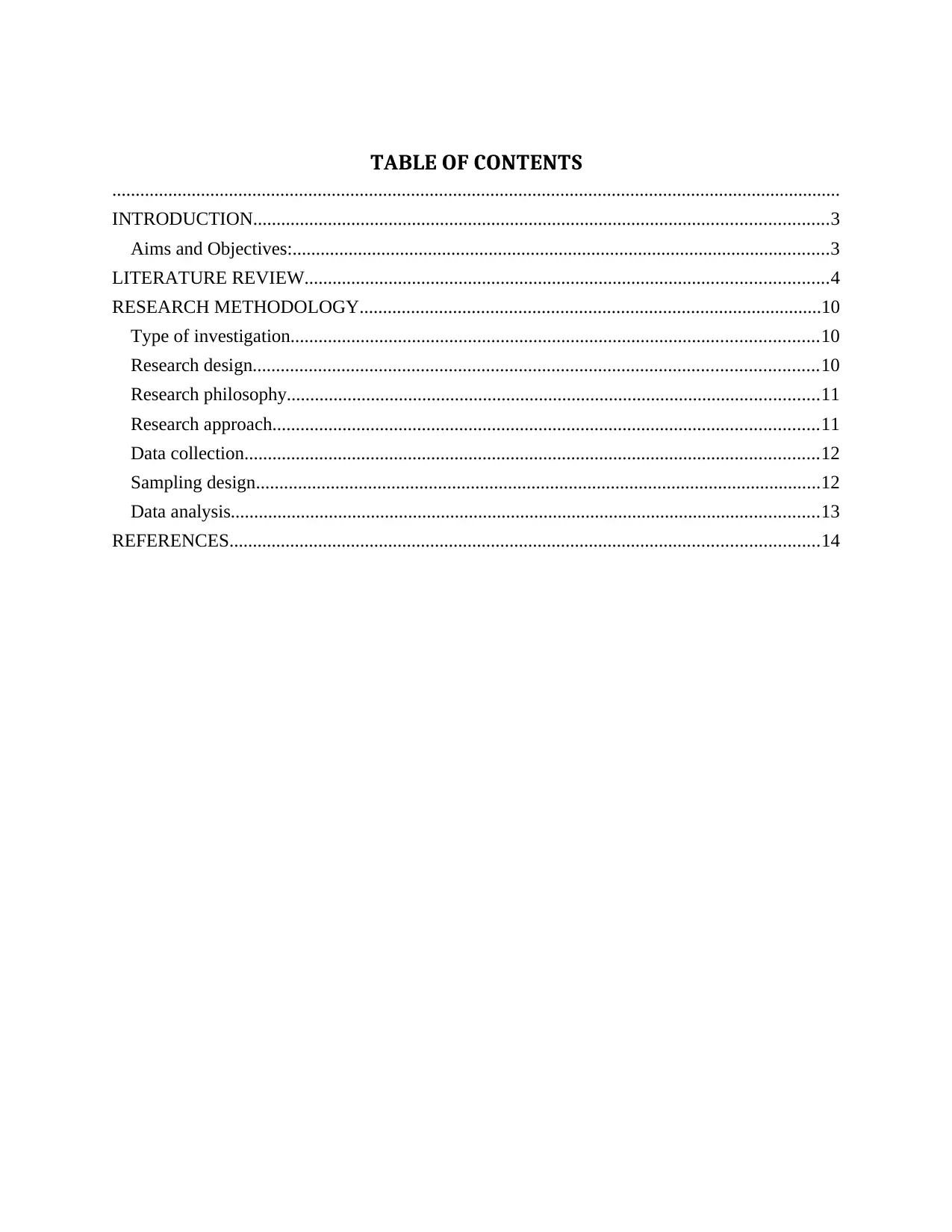
TABLE OF CONTENTS
............................................................................................................................................................
INTRODUCTION...........................................................................................................................3
Aims and Objectives:...................................................................................................................3
LITERATURE REVIEW................................................................................................................4
RESEARCH METHODOLOGY...................................................................................................10
Type of investigation.................................................................................................................10
Research design.........................................................................................................................10
Research philosophy..................................................................................................................11
Research approach.....................................................................................................................11
Data collection...........................................................................................................................12
Sampling design.........................................................................................................................12
Data analysis..............................................................................................................................13
REFERENCES..............................................................................................................................14
............................................................................................................................................................
INTRODUCTION...........................................................................................................................3
Aims and Objectives:...................................................................................................................3
LITERATURE REVIEW................................................................................................................4
RESEARCH METHODOLOGY...................................................................................................10
Type of investigation.................................................................................................................10
Research design.........................................................................................................................10
Research philosophy..................................................................................................................11
Research approach.....................................................................................................................11
Data collection...........................................................................................................................12
Sampling design.........................................................................................................................12
Data analysis..............................................................................................................................13
REFERENCES..............................................................................................................................14
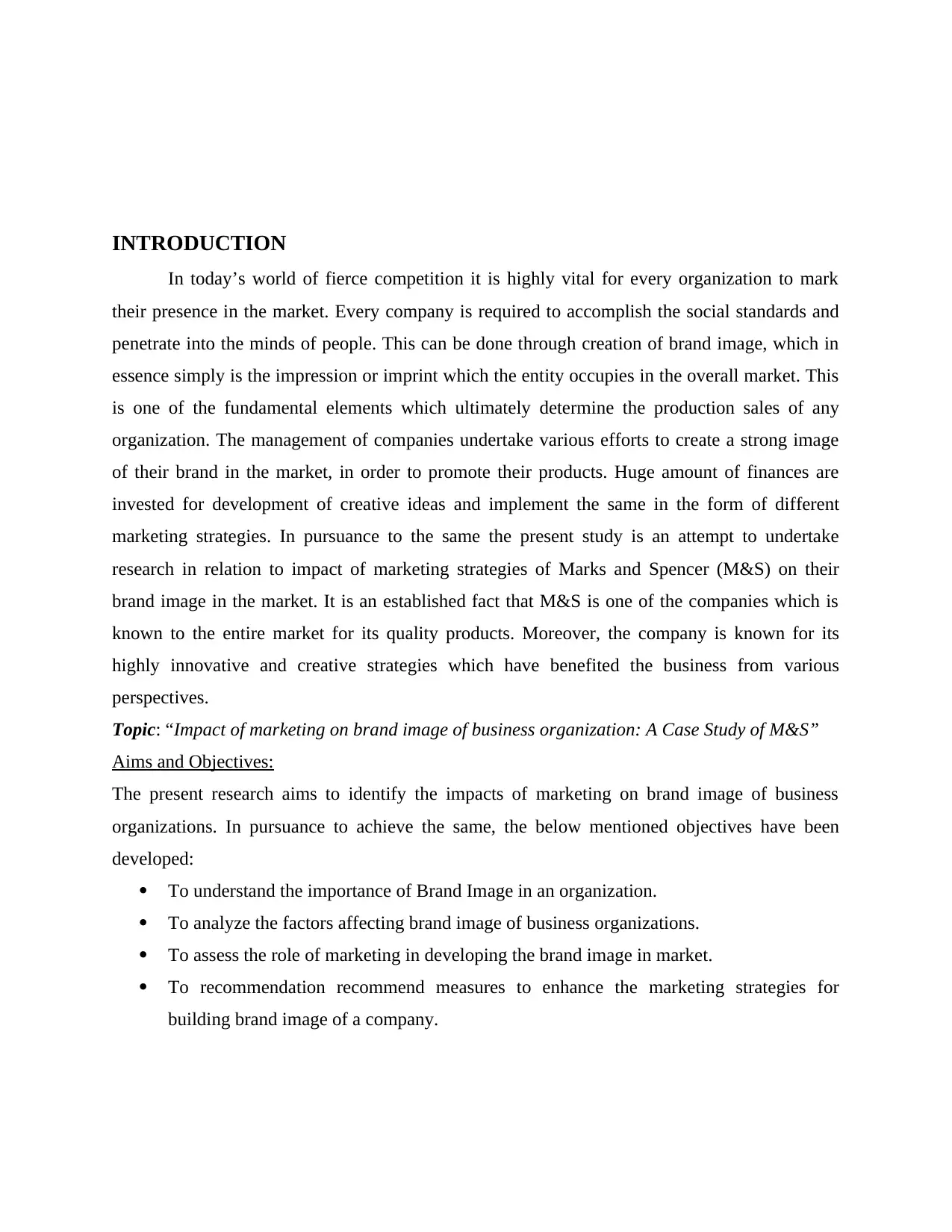
INTRODUCTION
In today’s world of fierce competition it is highly vital for every organization to mark
their presence in the market. Every company is required to accomplish the social standards and
penetrate into the minds of people. This can be done through creation of brand image, which in
essence simply is the impression or imprint which the entity occupies in the overall market. This
is one of the fundamental elements which ultimately determine the production sales of any
organization. The management of companies undertake various efforts to create a strong image
of their brand in the market, in order to promote their products. Huge amount of finances are
invested for development of creative ideas and implement the same in the form of different
marketing strategies. In pursuance to the same the present study is an attempt to undertake
research in relation to impact of marketing strategies of Marks and Spencer (M&S) on their
brand image in the market. It is an established fact that M&S is one of the companies which is
known to the entire market for its quality products. Moreover, the company is known for its
highly innovative and creative strategies which have benefited the business from various
perspectives.
Topic: “Impact of marketing on brand image of business organization: A Case Study of M&S”
Aims and Objectives:
The present research aims to identify the impacts of marketing on brand image of business
organizations. In pursuance to achieve the same, the below mentioned objectives have been
developed:
To understand the importance of Brand Image in an organization.
To analyze the factors affecting brand image of business organizations.
To assess the role of marketing in developing the brand image in market.
To recommendation recommend measures to enhance the marketing strategies for
building brand image of a company.
In today’s world of fierce competition it is highly vital for every organization to mark
their presence in the market. Every company is required to accomplish the social standards and
penetrate into the minds of people. This can be done through creation of brand image, which in
essence simply is the impression or imprint which the entity occupies in the overall market. This
is one of the fundamental elements which ultimately determine the production sales of any
organization. The management of companies undertake various efforts to create a strong image
of their brand in the market, in order to promote their products. Huge amount of finances are
invested for development of creative ideas and implement the same in the form of different
marketing strategies. In pursuance to the same the present study is an attempt to undertake
research in relation to impact of marketing strategies of Marks and Spencer (M&S) on their
brand image in the market. It is an established fact that M&S is one of the companies which is
known to the entire market for its quality products. Moreover, the company is known for its
highly innovative and creative strategies which have benefited the business from various
perspectives.
Topic: “Impact of marketing on brand image of business organization: A Case Study of M&S”
Aims and Objectives:
The present research aims to identify the impacts of marketing on brand image of business
organizations. In pursuance to achieve the same, the below mentioned objectives have been
developed:
To understand the importance of Brand Image in an organization.
To analyze the factors affecting brand image of business organizations.
To assess the role of marketing in developing the brand image in market.
To recommendation recommend measures to enhance the marketing strategies for
building brand image of a company.
⊘ This is a preview!⊘
Do you want full access?
Subscribe today to unlock all pages.

Trusted by 1+ million students worldwide
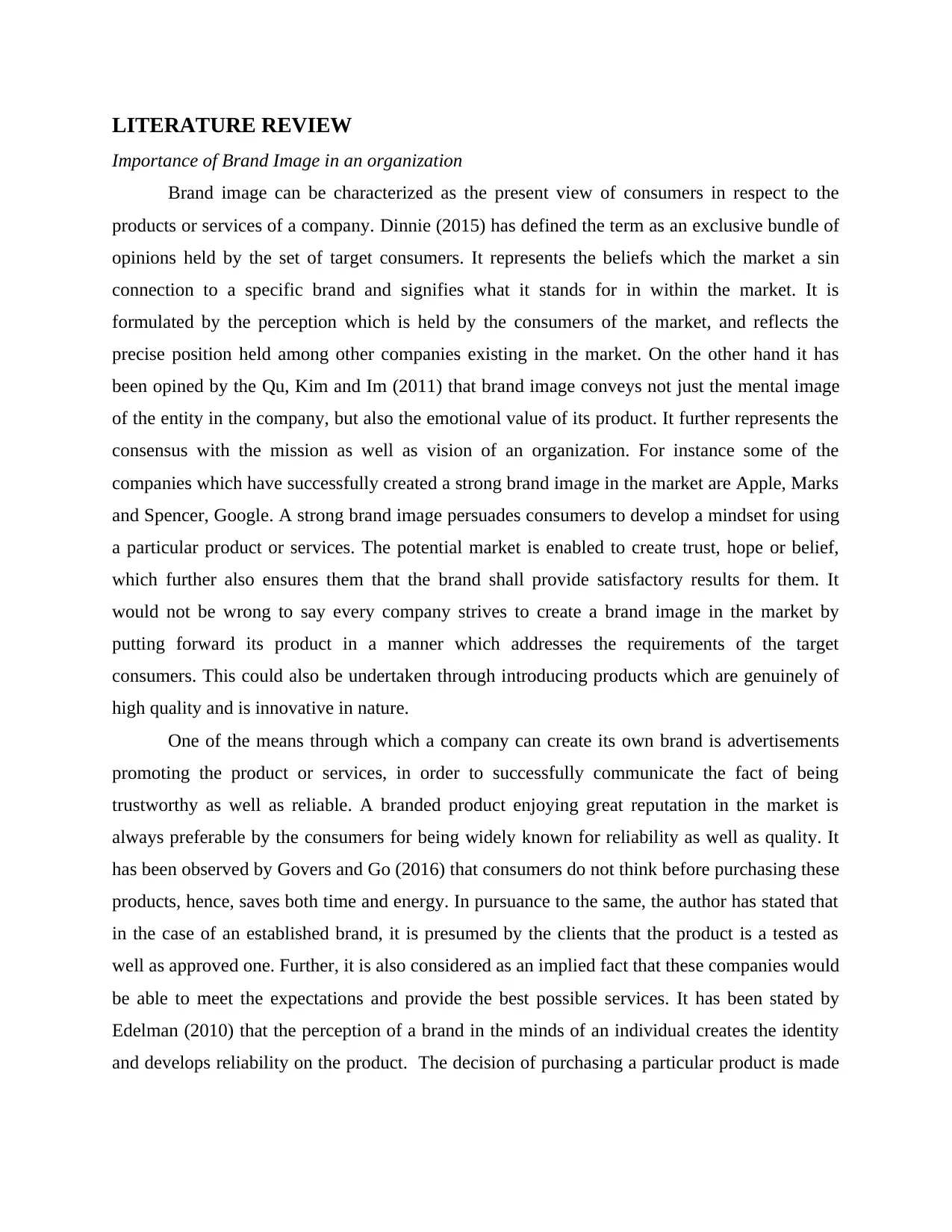
LITERATURE REVIEW
Importance of Brand Image in an organization
Brand image can be characterized as the present view of consumers in respect to the
products or services of a company. Dinnie (2015) has defined the term as an exclusive bundle of
opinions held by the set of target consumers. It represents the beliefs which the market a sin
connection to a specific brand and signifies what it stands for in within the market. It is
formulated by the perception which is held by the consumers of the market, and reflects the
precise position held among other companies existing in the market. On the other hand it has
been opined by the Qu, Kim and Im (2011) that brand image conveys not just the mental image
of the entity in the company, but also the emotional value of its product. It further represents the
consensus with the mission as well as vision of an organization. For instance some of the
companies which have successfully created a strong brand image in the market are Apple, Marks
and Spencer, Google. A strong brand image persuades consumers to develop a mindset for using
a particular product or services. The potential market is enabled to create trust, hope or belief,
which further also ensures them that the brand shall provide satisfactory results for them. It
would not be wrong to say every company strives to create a brand image in the market by
putting forward its product in a manner which addresses the requirements of the target
consumers. This could also be undertaken through introducing products which are genuinely of
high quality and is innovative in nature.
One of the means through which a company can create its own brand is advertisements
promoting the product or services, in order to successfully communicate the fact of being
trustworthy as well as reliable. A branded product enjoying great reputation in the market is
always preferable by the consumers for being widely known for reliability as well as quality. It
has been observed by Govers and Go (2016) that consumers do not think before purchasing these
products, hence, saves both time and energy. In pursuance to the same, the author has stated that
in the case of an established brand, it is presumed by the clients that the product is a tested as
well as approved one. Further, it is also considered as an implied fact that these companies would
be able to meet the expectations and provide the best possible services. It has been stated by
Edelman (2010) that the perception of a brand in the minds of an individual creates the identity
and develops reliability on the product. The decision of purchasing a particular product is made
Importance of Brand Image in an organization
Brand image can be characterized as the present view of consumers in respect to the
products or services of a company. Dinnie (2015) has defined the term as an exclusive bundle of
opinions held by the set of target consumers. It represents the beliefs which the market a sin
connection to a specific brand and signifies what it stands for in within the market. It is
formulated by the perception which is held by the consumers of the market, and reflects the
precise position held among other companies existing in the market. On the other hand it has
been opined by the Qu, Kim and Im (2011) that brand image conveys not just the mental image
of the entity in the company, but also the emotional value of its product. It further represents the
consensus with the mission as well as vision of an organization. For instance some of the
companies which have successfully created a strong brand image in the market are Apple, Marks
and Spencer, Google. A strong brand image persuades consumers to develop a mindset for using
a particular product or services. The potential market is enabled to create trust, hope or belief,
which further also ensures them that the brand shall provide satisfactory results for them. It
would not be wrong to say every company strives to create a brand image in the market by
putting forward its product in a manner which addresses the requirements of the target
consumers. This could also be undertaken through introducing products which are genuinely of
high quality and is innovative in nature.
One of the means through which a company can create its own brand is advertisements
promoting the product or services, in order to successfully communicate the fact of being
trustworthy as well as reliable. A branded product enjoying great reputation in the market is
always preferable by the consumers for being widely known for reliability as well as quality. It
has been observed by Govers and Go (2016) that consumers do not think before purchasing these
products, hence, saves both time and energy. In pursuance to the same, the author has stated that
in the case of an established brand, it is presumed by the clients that the product is a tested as
well as approved one. Further, it is also considered as an implied fact that these companies would
be able to meet the expectations and provide the best possible services. It has been stated by
Edelman (2010) that the perception of a brand in the minds of an individual creates the identity
and develops reliability on the product. The decision of purchasing a particular product is made
Paraphrase This Document
Need a fresh take? Get an instant paraphrase of this document with our AI Paraphraser
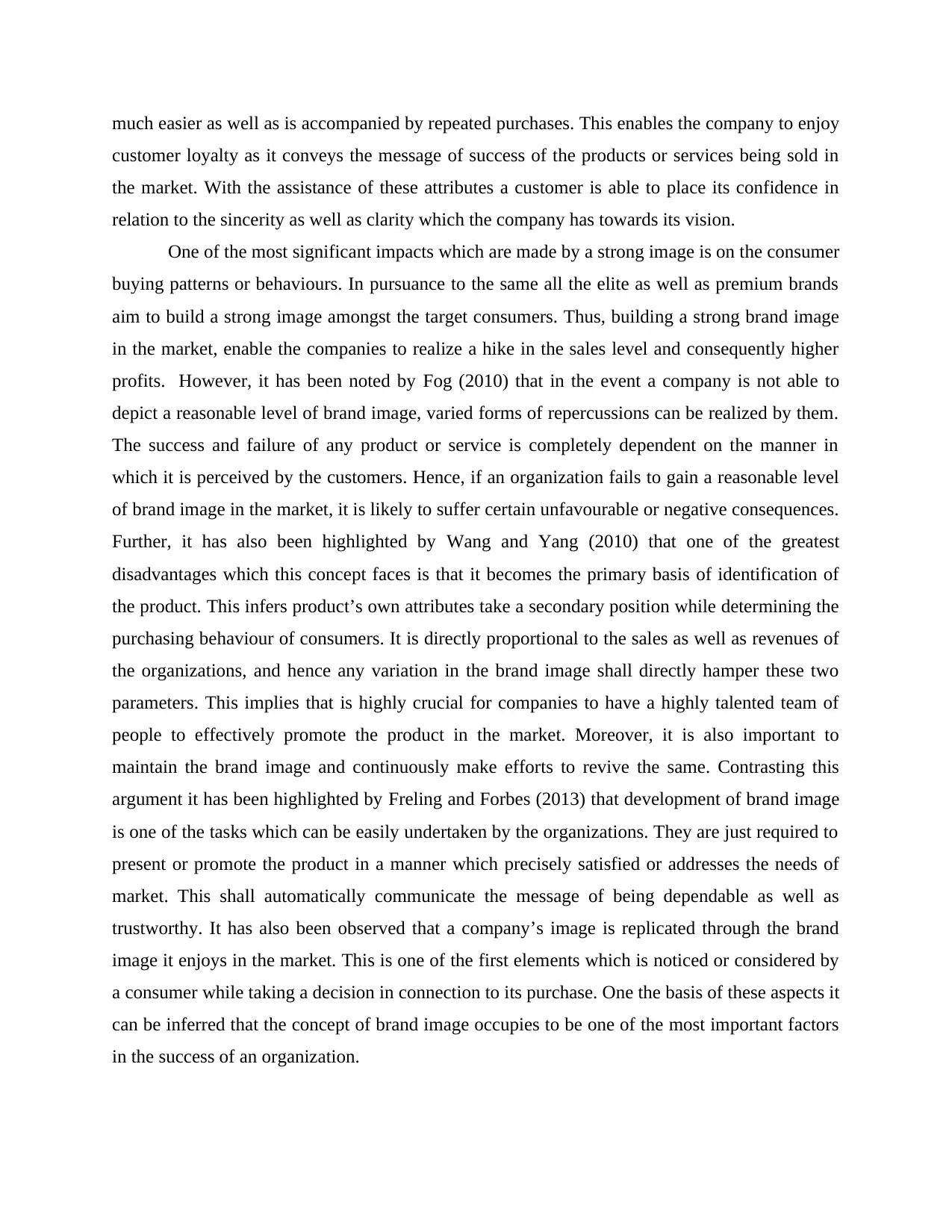
much easier as well as is accompanied by repeated purchases. This enables the company to enjoy
customer loyalty as it conveys the message of success of the products or services being sold in
the market. With the assistance of these attributes a customer is able to place its confidence in
relation to the sincerity as well as clarity which the company has towards its vision.
One of the most significant impacts which are made by a strong image is on the consumer
buying patterns or behaviours. In pursuance to the same all the elite as well as premium brands
aim to build a strong image amongst the target consumers. Thus, building a strong brand image
in the market, enable the companies to realize a hike in the sales level and consequently higher
profits. However, it has been noted by Fog (2010) that in the event a company is not able to
depict a reasonable level of brand image, varied forms of repercussions can be realized by them.
The success and failure of any product or service is completely dependent on the manner in
which it is perceived by the customers. Hence, if an organization fails to gain a reasonable level
of brand image in the market, it is likely to suffer certain unfavourable or negative consequences.
Further, it has also been highlighted by Wang and Yang (2010) that one of the greatest
disadvantages which this concept faces is that it becomes the primary basis of identification of
the product. This infers product’s own attributes take a secondary position while determining the
purchasing behaviour of consumers. It is directly proportional to the sales as well as revenues of
the organizations, and hence any variation in the brand image shall directly hamper these two
parameters. This implies that is highly crucial for companies to have a highly talented team of
people to effectively promote the product in the market. Moreover, it is also important to
maintain the brand image and continuously make efforts to revive the same. Contrasting this
argument it has been highlighted by Freling and Forbes (2013) that development of brand image
is one of the tasks which can be easily undertaken by the organizations. They are just required to
present or promote the product in a manner which precisely satisfied or addresses the needs of
market. This shall automatically communicate the message of being dependable as well as
trustworthy. It has also been observed that a company’s image is replicated through the brand
image it enjoys in the market. This is one of the first elements which is noticed or considered by
a consumer while taking a decision in connection to its purchase. One the basis of these aspects it
can be inferred that the concept of brand image occupies to be one of the most important factors
in the success of an organization.
customer loyalty as it conveys the message of success of the products or services being sold in
the market. With the assistance of these attributes a customer is able to place its confidence in
relation to the sincerity as well as clarity which the company has towards its vision.
One of the most significant impacts which are made by a strong image is on the consumer
buying patterns or behaviours. In pursuance to the same all the elite as well as premium brands
aim to build a strong image amongst the target consumers. Thus, building a strong brand image
in the market, enable the companies to realize a hike in the sales level and consequently higher
profits. However, it has been noted by Fog (2010) that in the event a company is not able to
depict a reasonable level of brand image, varied forms of repercussions can be realized by them.
The success and failure of any product or service is completely dependent on the manner in
which it is perceived by the customers. Hence, if an organization fails to gain a reasonable level
of brand image in the market, it is likely to suffer certain unfavourable or negative consequences.
Further, it has also been highlighted by Wang and Yang (2010) that one of the greatest
disadvantages which this concept faces is that it becomes the primary basis of identification of
the product. This infers product’s own attributes take a secondary position while determining the
purchasing behaviour of consumers. It is directly proportional to the sales as well as revenues of
the organizations, and hence any variation in the brand image shall directly hamper these two
parameters. This implies that is highly crucial for companies to have a highly talented team of
people to effectively promote the product in the market. Moreover, it is also important to
maintain the brand image and continuously make efforts to revive the same. Contrasting this
argument it has been highlighted by Freling and Forbes (2013) that development of brand image
is one of the tasks which can be easily undertaken by the organizations. They are just required to
present or promote the product in a manner which precisely satisfied or addresses the needs of
market. This shall automatically communicate the message of being dependable as well as
trustworthy. It has also been observed that a company’s image is replicated through the brand
image it enjoys in the market. This is one of the first elements which is noticed or considered by
a consumer while taking a decision in connection to its purchase. One the basis of these aspects it
can be inferred that the concept of brand image occupies to be one of the most important factors
in the success of an organization.
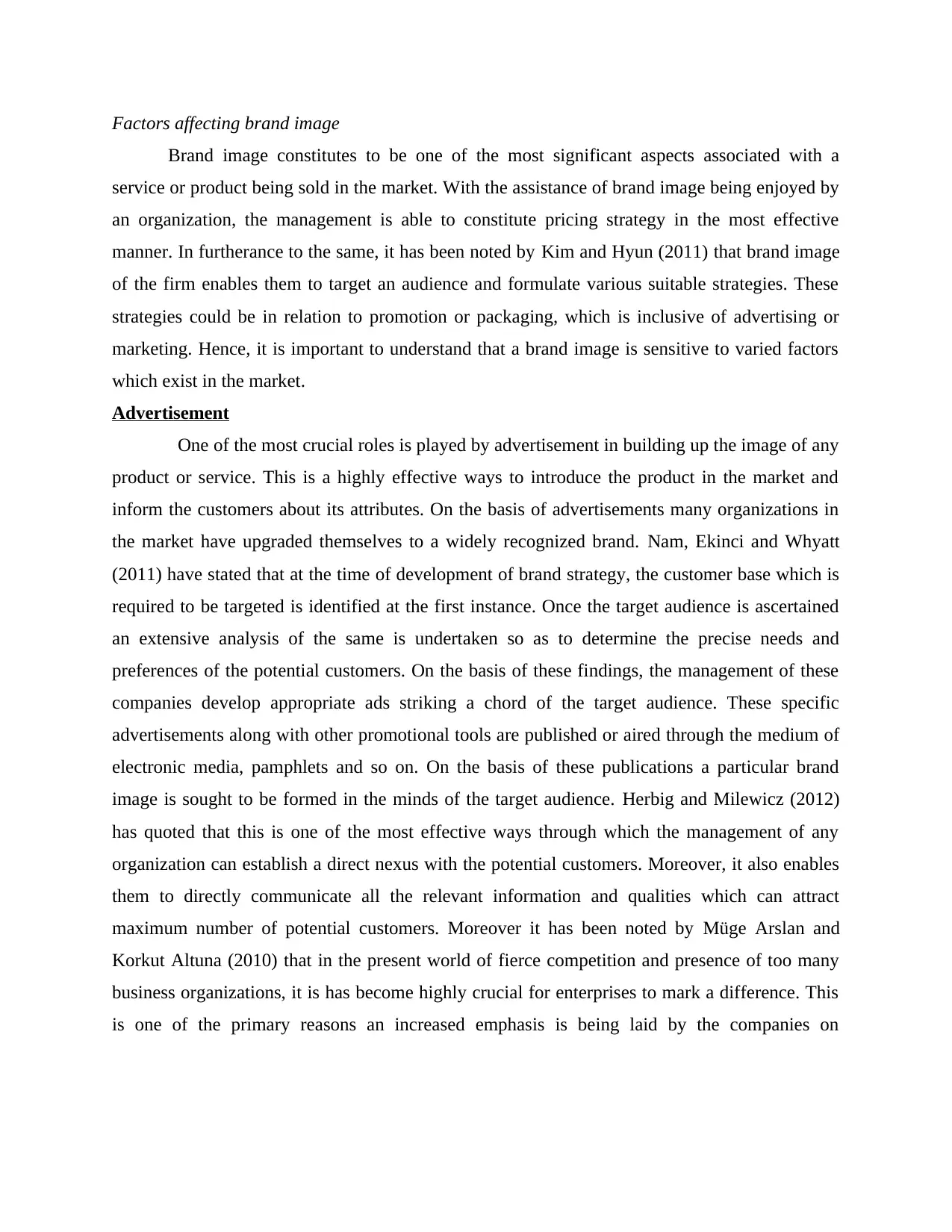
Factors affecting brand image
Brand image constitutes to be one of the most significant aspects associated with a
service or product being sold in the market. With the assistance of brand image being enjoyed by
an organization, the management is able to constitute pricing strategy in the most effective
manner. In furtherance to the same, it has been noted by Kim and Hyun (2011) that brand image
of the firm enables them to target an audience and formulate various suitable strategies. These
strategies could be in relation to promotion or packaging, which is inclusive of advertising or
marketing. Hence, it is important to understand that a brand image is sensitive to varied factors
which exist in the market.
Advertisement
One of the most crucial roles is played by advertisement in building up the image of any
product or service. This is a highly effective ways to introduce the product in the market and
inform the customers about its attributes. On the basis of advertisements many organizations in
the market have upgraded themselves to a widely recognized brand. Nam, Ekinci and Whyatt
(2011) have stated that at the time of development of brand strategy, the customer base which is
required to be targeted is identified at the first instance. Once the target audience is ascertained
an extensive analysis of the same is undertaken so as to determine the precise needs and
preferences of the potential customers. On the basis of these findings, the management of these
companies develop appropriate ads striking a chord of the target audience. These specific
advertisements along with other promotional tools are published or aired through the medium of
electronic media, pamphlets and so on. On the basis of these publications a particular brand
image is sought to be formed in the minds of the target audience. Herbig and Milewicz (2012)
has quoted that this is one of the most effective ways through which the management of any
organization can establish a direct nexus with the potential customers. Moreover, it also enables
them to directly communicate all the relevant information and qualities which can attract
maximum number of potential customers. Moreover it has been noted by Müge Arslan and
Korkut Altuna (2010) that in the present world of fierce competition and presence of too many
business organizations, it is has become highly crucial for enterprises to mark a difference. This
is one of the primary reasons an increased emphasis is being laid by the companies on
Brand image constitutes to be one of the most significant aspects associated with a
service or product being sold in the market. With the assistance of brand image being enjoyed by
an organization, the management is able to constitute pricing strategy in the most effective
manner. In furtherance to the same, it has been noted by Kim and Hyun (2011) that brand image
of the firm enables them to target an audience and formulate various suitable strategies. These
strategies could be in relation to promotion or packaging, which is inclusive of advertising or
marketing. Hence, it is important to understand that a brand image is sensitive to varied factors
which exist in the market.
Advertisement
One of the most crucial roles is played by advertisement in building up the image of any
product or service. This is a highly effective ways to introduce the product in the market and
inform the customers about its attributes. On the basis of advertisements many organizations in
the market have upgraded themselves to a widely recognized brand. Nam, Ekinci and Whyatt
(2011) have stated that at the time of development of brand strategy, the customer base which is
required to be targeted is identified at the first instance. Once the target audience is ascertained
an extensive analysis of the same is undertaken so as to determine the precise needs and
preferences of the potential customers. On the basis of these findings, the management of these
companies develop appropriate ads striking a chord of the target audience. These specific
advertisements along with other promotional tools are published or aired through the medium of
electronic media, pamphlets and so on. On the basis of these publications a particular brand
image is sought to be formed in the minds of the target audience. Herbig and Milewicz (2012)
has quoted that this is one of the most effective ways through which the management of any
organization can establish a direct nexus with the potential customers. Moreover, it also enables
them to directly communicate all the relevant information and qualities which can attract
maximum number of potential customers. Moreover it has been noted by Müge Arslan and
Korkut Altuna (2010) that in the present world of fierce competition and presence of too many
business organizations, it is has become highly crucial for enterprises to mark a difference. This
is one of the primary reasons an increased emphasis is being laid by the companies on
⊘ This is a preview!⊘
Do you want full access?
Subscribe today to unlock all pages.

Trusted by 1+ million students worldwide
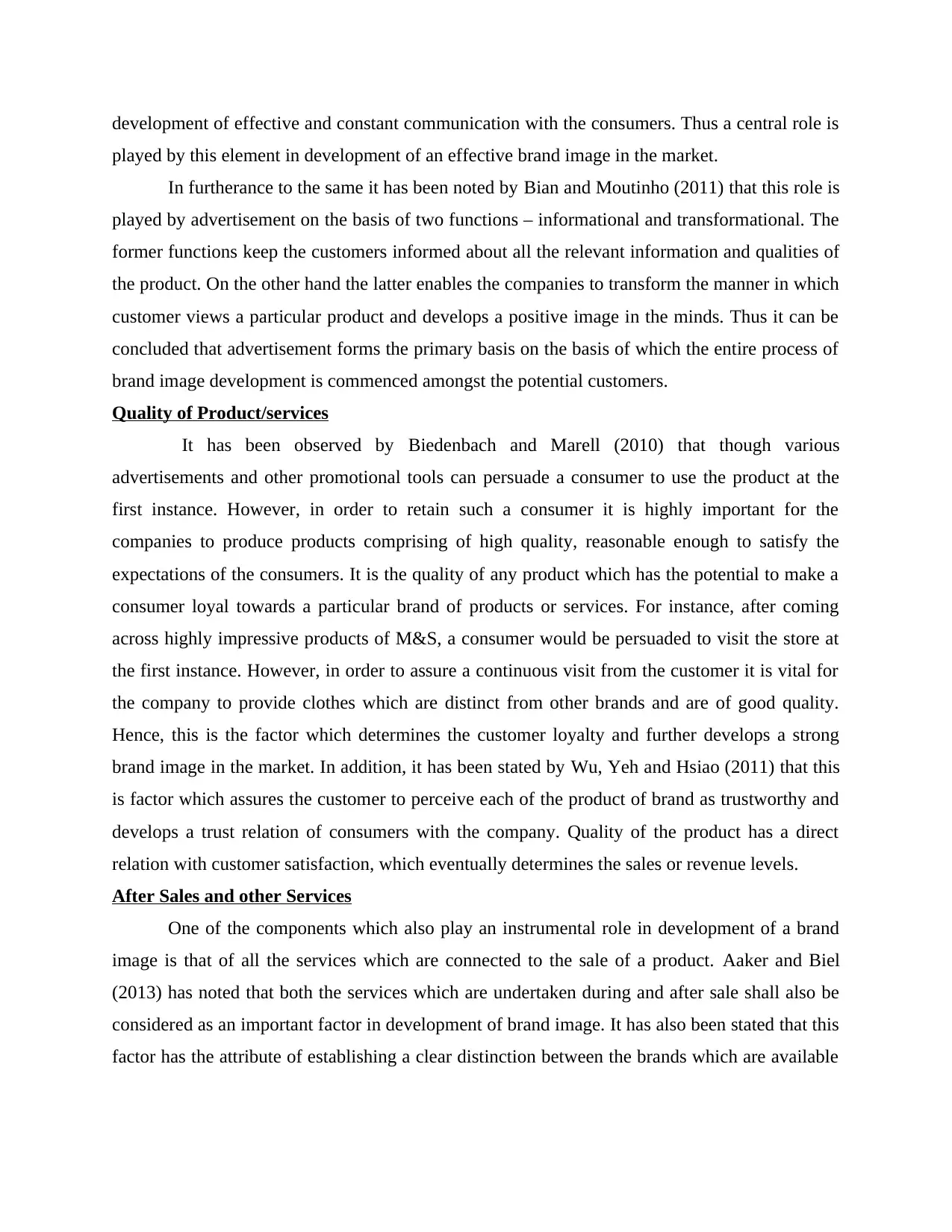
development of effective and constant communication with the consumers. Thus a central role is
played by this element in development of an effective brand image in the market.
In furtherance to the same it has been noted by Bian and Moutinho (2011) that this role is
played by advertisement on the basis of two functions – informational and transformational. The
former functions keep the customers informed about all the relevant information and qualities of
the product. On the other hand the latter enables the companies to transform the manner in which
customer views a particular product and develops a positive image in the minds. Thus it can be
concluded that advertisement forms the primary basis on the basis of which the entire process of
brand image development is commenced amongst the potential customers.
Quality of Product/services
It has been observed by Biedenbach and Marell (2010) that though various
advertisements and other promotional tools can persuade a consumer to use the product at the
first instance. However, in order to retain such a consumer it is highly important for the
companies to produce products comprising of high quality, reasonable enough to satisfy the
expectations of the consumers. It is the quality of any product which has the potential to make a
consumer loyal towards a particular brand of products or services. For instance, after coming
across highly impressive products of M&S, a consumer would be persuaded to visit the store at
the first instance. However, in order to assure a continuous visit from the customer it is vital for
the company to provide clothes which are distinct from other brands and are of good quality.
Hence, this is the factor which determines the customer loyalty and further develops a strong
brand image in the market. In addition, it has been stated by Wu, Yeh and Hsiao (2011) that this
is factor which assures the customer to perceive each of the product of brand as trustworthy and
develops a trust relation of consumers with the company. Quality of the product has a direct
relation with customer satisfaction, which eventually determines the sales or revenue levels.
After Sales and other Services
One of the components which also play an instrumental role in development of a brand
image is that of all the services which are connected to the sale of a product. Aaker and Biel
(2013) has noted that both the services which are undertaken during and after sale shall also be
considered as an important factor in development of brand image. It has also been stated that this
factor has the attribute of establishing a clear distinction between the brands which are available
played by this element in development of an effective brand image in the market.
In furtherance to the same it has been noted by Bian and Moutinho (2011) that this role is
played by advertisement on the basis of two functions – informational and transformational. The
former functions keep the customers informed about all the relevant information and qualities of
the product. On the other hand the latter enables the companies to transform the manner in which
customer views a particular product and develops a positive image in the minds. Thus it can be
concluded that advertisement forms the primary basis on the basis of which the entire process of
brand image development is commenced amongst the potential customers.
Quality of Product/services
It has been observed by Biedenbach and Marell (2010) that though various
advertisements and other promotional tools can persuade a consumer to use the product at the
first instance. However, in order to retain such a consumer it is highly important for the
companies to produce products comprising of high quality, reasonable enough to satisfy the
expectations of the consumers. It is the quality of any product which has the potential to make a
consumer loyal towards a particular brand of products or services. For instance, after coming
across highly impressive products of M&S, a consumer would be persuaded to visit the store at
the first instance. However, in order to assure a continuous visit from the customer it is vital for
the company to provide clothes which are distinct from other brands and are of good quality.
Hence, this is the factor which determines the customer loyalty and further develops a strong
brand image in the market. In addition, it has been stated by Wu, Yeh and Hsiao (2011) that this
is factor which assures the customer to perceive each of the product of brand as trustworthy and
develops a trust relation of consumers with the company. Quality of the product has a direct
relation with customer satisfaction, which eventually determines the sales or revenue levels.
After Sales and other Services
One of the components which also play an instrumental role in development of a brand
image is that of all the services which are connected to the sale of a product. Aaker and Biel
(2013) has noted that both the services which are undertaken during and after sale shall also be
considered as an important factor in development of brand image. It has also been stated that this
factor has the attribute of establishing a clear distinction between the brands which are available
Paraphrase This Document
Need a fresh take? Get an instant paraphrase of this document with our AI Paraphraser
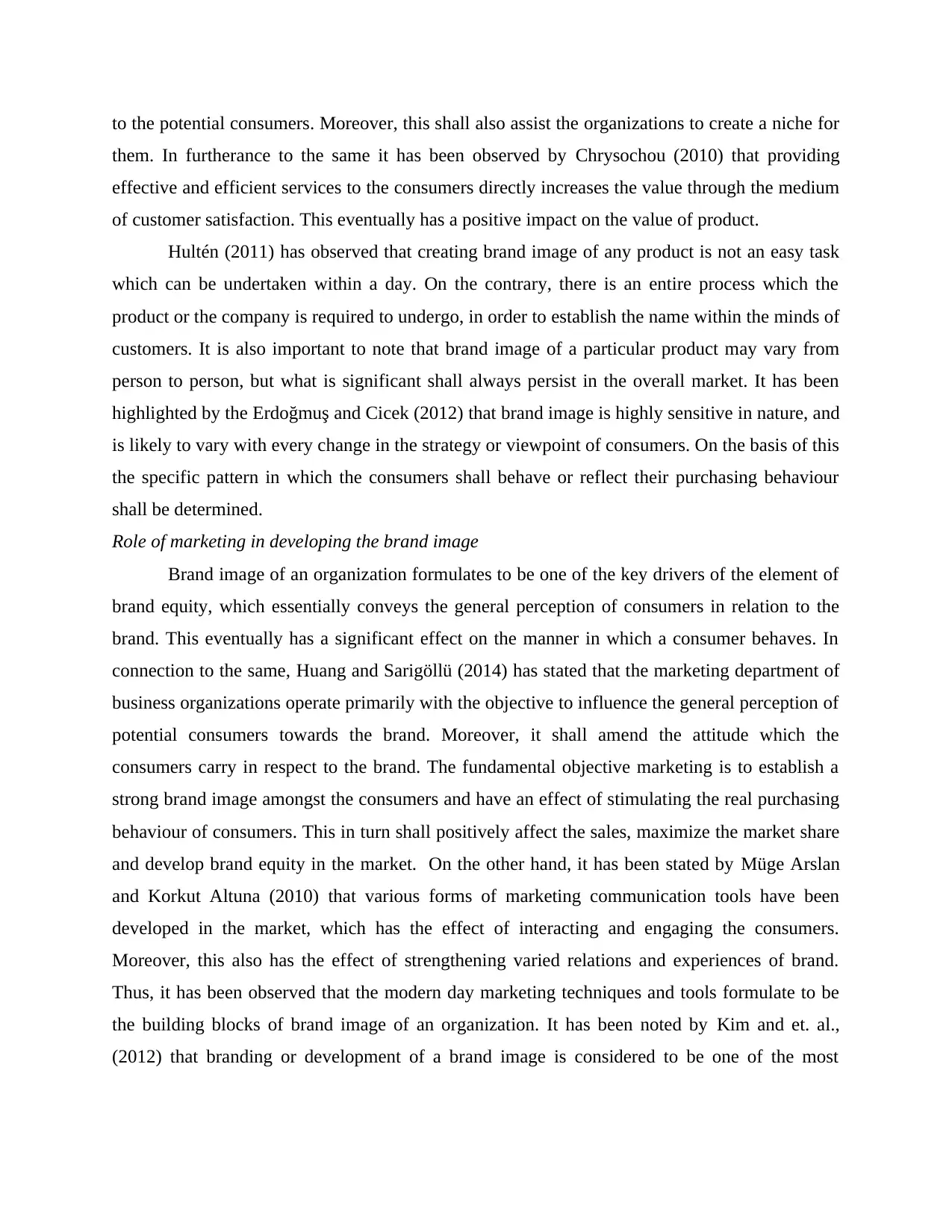
to the potential consumers. Moreover, this shall also assist the organizations to create a niche for
them. In furtherance to the same it has been observed by Chrysochou (2010) that providing
effective and efficient services to the consumers directly increases the value through the medium
of customer satisfaction. This eventually has a positive impact on the value of product.
Hultén (2011) has observed that creating brand image of any product is not an easy task
which can be undertaken within a day. On the contrary, there is an entire process which the
product or the company is required to undergo, in order to establish the name within the minds of
customers. It is also important to note that brand image of a particular product may vary from
person to person, but what is significant shall always persist in the overall market. It has been
highlighted by the Erdoğmuş and Cicek (2012) that brand image is highly sensitive in nature, and
is likely to vary with every change in the strategy or viewpoint of consumers. On the basis of this
the specific pattern in which the consumers shall behave or reflect their purchasing behaviour
shall be determined.
Role of marketing in developing the brand image
Brand image of an organization formulates to be one of the key drivers of the element of
brand equity, which essentially conveys the general perception of consumers in relation to the
brand. This eventually has a significant effect on the manner in which a consumer behaves. In
connection to the same, Huang and Sarigöllü (2014) has stated that the marketing department of
business organizations operate primarily with the objective to influence the general perception of
potential consumers towards the brand. Moreover, it shall amend the attitude which the
consumers carry in respect to the brand. The fundamental objective marketing is to establish a
strong brand image amongst the consumers and have an effect of stimulating the real purchasing
behaviour of consumers. This in turn shall positively affect the sales, maximize the market share
and develop brand equity in the market. On the other hand, it has been stated by Müge Arslan
and Korkut Altuna (2010) that various forms of marketing communication tools have been
developed in the market, which has the effect of interacting and engaging the consumers.
Moreover, this also has the effect of strengthening varied relations and experiences of brand.
Thus, it has been observed that the modern day marketing techniques and tools formulate to be
the building blocks of brand image of an organization. It has been noted by Kim and et. al.,
(2012) that branding or development of a brand image is considered to be one of the most
them. In furtherance to the same it has been observed by Chrysochou (2010) that providing
effective and efficient services to the consumers directly increases the value through the medium
of customer satisfaction. This eventually has a positive impact on the value of product.
Hultén (2011) has observed that creating brand image of any product is not an easy task
which can be undertaken within a day. On the contrary, there is an entire process which the
product or the company is required to undergo, in order to establish the name within the minds of
customers. It is also important to note that brand image of a particular product may vary from
person to person, but what is significant shall always persist in the overall market. It has been
highlighted by the Erdoğmuş and Cicek (2012) that brand image is highly sensitive in nature, and
is likely to vary with every change in the strategy or viewpoint of consumers. On the basis of this
the specific pattern in which the consumers shall behave or reflect their purchasing behaviour
shall be determined.
Role of marketing in developing the brand image
Brand image of an organization formulates to be one of the key drivers of the element of
brand equity, which essentially conveys the general perception of consumers in relation to the
brand. This eventually has a significant effect on the manner in which a consumer behaves. In
connection to the same, Huang and Sarigöllü (2014) has stated that the marketing department of
business organizations operate primarily with the objective to influence the general perception of
potential consumers towards the brand. Moreover, it shall amend the attitude which the
consumers carry in respect to the brand. The fundamental objective marketing is to establish a
strong brand image amongst the consumers and have an effect of stimulating the real purchasing
behaviour of consumers. This in turn shall positively affect the sales, maximize the market share
and develop brand equity in the market. On the other hand, it has been stated by Müge Arslan
and Korkut Altuna (2010) that various forms of marketing communication tools have been
developed in the market, which has the effect of interacting and engaging the consumers.
Moreover, this also has the effect of strengthening varied relations and experiences of brand.
Thus, it has been observed that the modern day marketing techniques and tools formulate to be
the building blocks of brand image of an organization. It has been noted by Kim and et. al.,
(2012) that branding or development of a brand image is considered to be one of the most
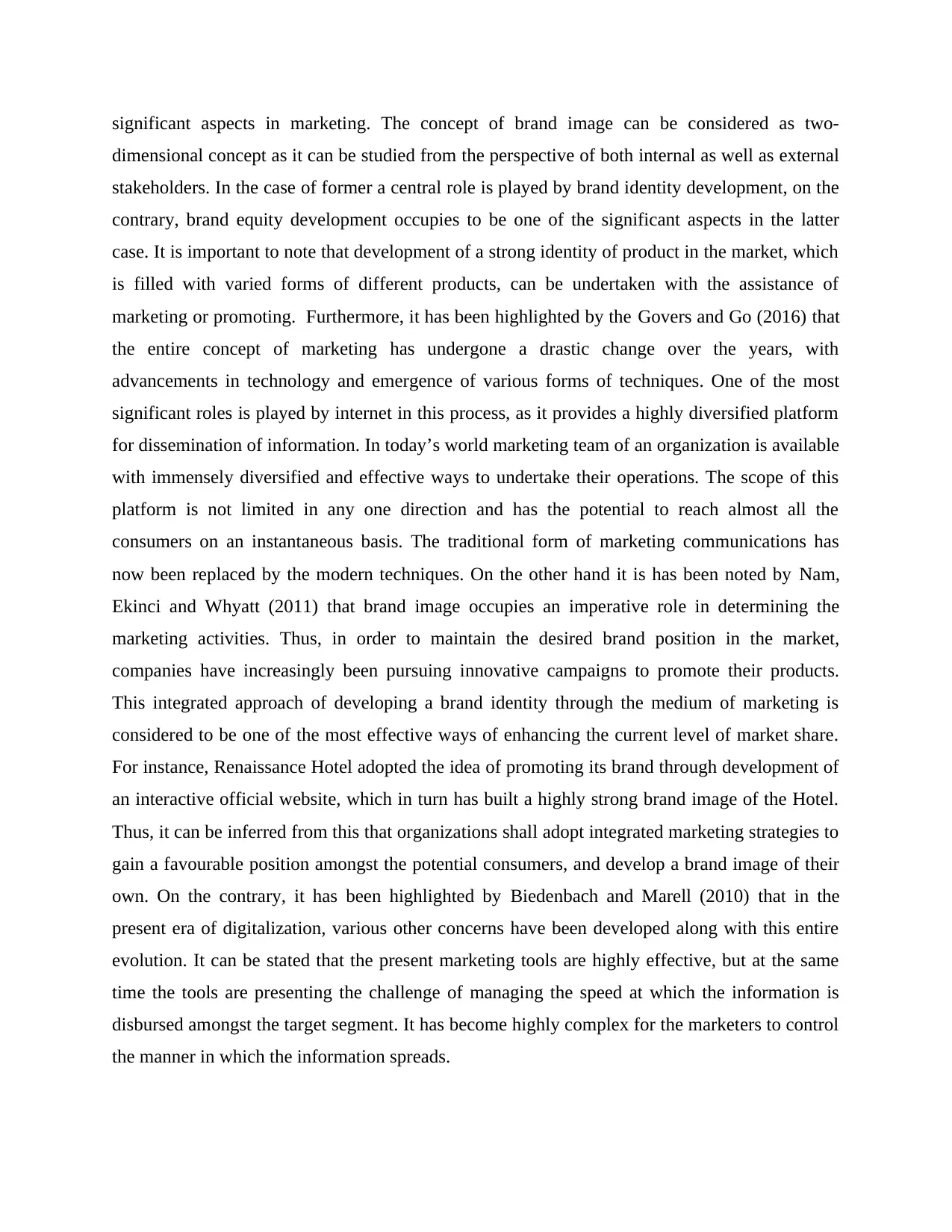
significant aspects in marketing. The concept of brand image can be considered as two-
dimensional concept as it can be studied from the perspective of both internal as well as external
stakeholders. In the case of former a central role is played by brand identity development, on the
contrary, brand equity development occupies to be one of the significant aspects in the latter
case. It is important to note that development of a strong identity of product in the market, which
is filled with varied forms of different products, can be undertaken with the assistance of
marketing or promoting. Furthermore, it has been highlighted by the Govers and Go (2016) that
the entire concept of marketing has undergone a drastic change over the years, with
advancements in technology and emergence of various forms of techniques. One of the most
significant roles is played by internet in this process, as it provides a highly diversified platform
for dissemination of information. In today’s world marketing team of an organization is available
with immensely diversified and effective ways to undertake their operations. The scope of this
platform is not limited in any one direction and has the potential to reach almost all the
consumers on an instantaneous basis. The traditional form of marketing communications has
now been replaced by the modern techniques. On the other hand it is has been noted by Nam,
Ekinci and Whyatt (2011) that brand image occupies an imperative role in determining the
marketing activities. Thus, in order to maintain the desired brand position in the market,
companies have increasingly been pursuing innovative campaigns to promote their products.
This integrated approach of developing a brand identity through the medium of marketing is
considered to be one of the most effective ways of enhancing the current level of market share.
For instance, Renaissance Hotel adopted the idea of promoting its brand through development of
an interactive official website, which in turn has built a highly strong brand image of the Hotel.
Thus, it can be inferred from this that organizations shall adopt integrated marketing strategies to
gain a favourable position amongst the potential consumers, and develop a brand image of their
own. On the contrary, it has been highlighted by Biedenbach and Marell (2010) that in the
present era of digitalization, various other concerns have been developed along with this entire
evolution. It can be stated that the present marketing tools are highly effective, but at the same
time the tools are presenting the challenge of managing the speed at which the information is
disbursed amongst the target segment. It has become highly complex for the marketers to control
the manner in which the information spreads.
dimensional concept as it can be studied from the perspective of both internal as well as external
stakeholders. In the case of former a central role is played by brand identity development, on the
contrary, brand equity development occupies to be one of the significant aspects in the latter
case. It is important to note that development of a strong identity of product in the market, which
is filled with varied forms of different products, can be undertaken with the assistance of
marketing or promoting. Furthermore, it has been highlighted by the Govers and Go (2016) that
the entire concept of marketing has undergone a drastic change over the years, with
advancements in technology and emergence of various forms of techniques. One of the most
significant roles is played by internet in this process, as it provides a highly diversified platform
for dissemination of information. In today’s world marketing team of an organization is available
with immensely diversified and effective ways to undertake their operations. The scope of this
platform is not limited in any one direction and has the potential to reach almost all the
consumers on an instantaneous basis. The traditional form of marketing communications has
now been replaced by the modern techniques. On the other hand it is has been noted by Nam,
Ekinci and Whyatt (2011) that brand image occupies an imperative role in determining the
marketing activities. Thus, in order to maintain the desired brand position in the market,
companies have increasingly been pursuing innovative campaigns to promote their products.
This integrated approach of developing a brand identity through the medium of marketing is
considered to be one of the most effective ways of enhancing the current level of market share.
For instance, Renaissance Hotel adopted the idea of promoting its brand through development of
an interactive official website, which in turn has built a highly strong brand image of the Hotel.
Thus, it can be inferred from this that organizations shall adopt integrated marketing strategies to
gain a favourable position amongst the potential consumers, and develop a brand image of their
own. On the contrary, it has been highlighted by Biedenbach and Marell (2010) that in the
present era of digitalization, various other concerns have been developed along with this entire
evolution. It can be stated that the present marketing tools are highly effective, but at the same
time the tools are presenting the challenge of managing the speed at which the information is
disbursed amongst the target segment. It has become highly complex for the marketers to control
the manner in which the information spreads.
⊘ This is a preview!⊘
Do you want full access?
Subscribe today to unlock all pages.

Trusted by 1+ million students worldwide
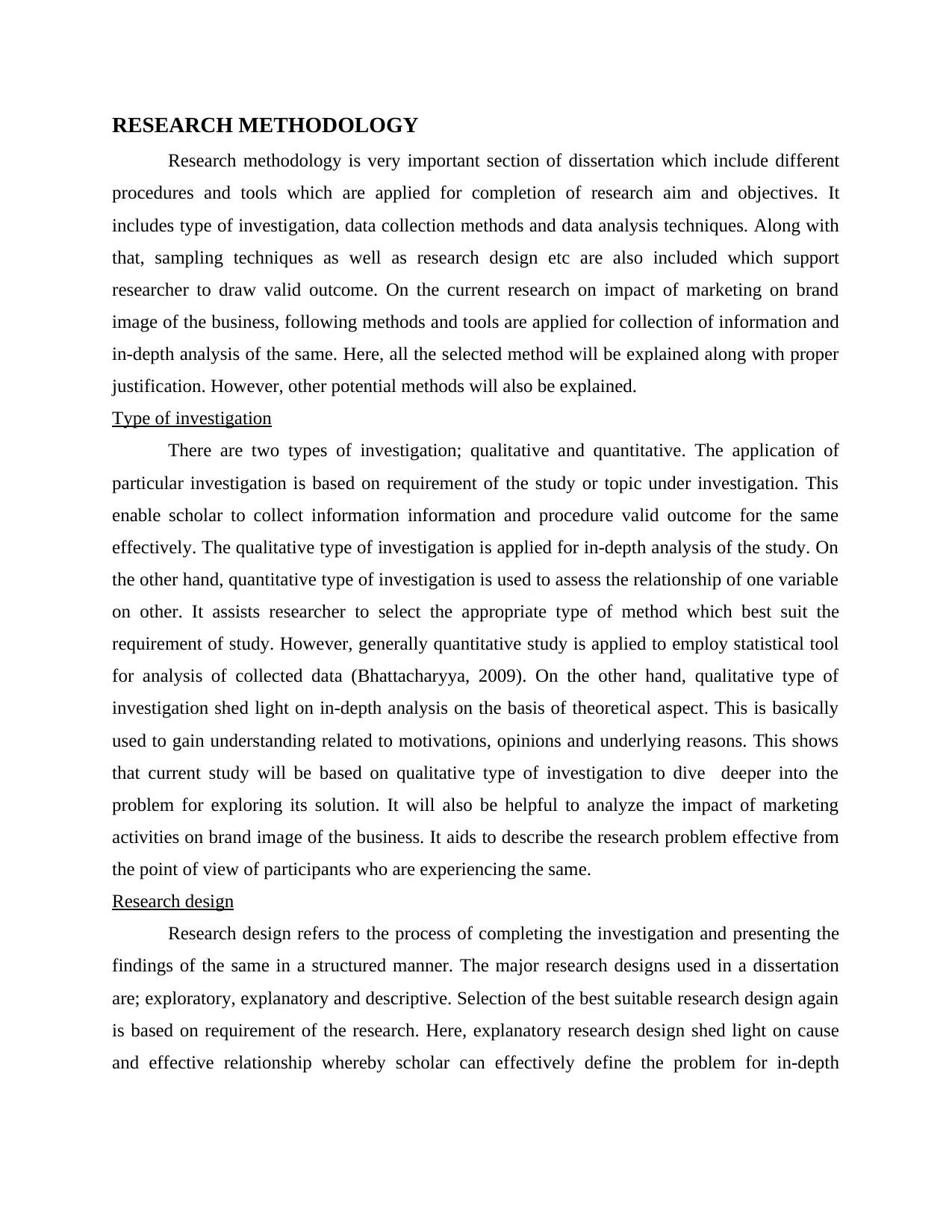
RESEARCH METHODOLOGY
Research methodology is very important section of dissertation which include different
procedures and tools which are applied for completion of research aim and objectives. It
includes type of investigation, data collection methods and data analysis techniques. Along with
that, sampling techniques as well as research design etc are also included which support
researcher to draw valid outcome. On the current research on impact of marketing on brand
image of the business, following methods and tools are applied for collection of information and
in-depth analysis of the same. Here, all the selected method will be explained along with proper
justification. However, other potential methods will also be explained.
Type of investigation
There are two types of investigation; qualitative and quantitative. The application of
particular investigation is based on requirement of the study or topic under investigation. This
enable scholar to collect information information and procedure valid outcome for the same
effectively. The qualitative type of investigation is applied for in-depth analysis of the study. On
the other hand, quantitative type of investigation is used to assess the relationship of one variable
on other. It assists researcher to select the appropriate type of method which best suit the
requirement of study. However, generally quantitative study is applied to employ statistical tool
for analysis of collected data (Bhattacharyya, 2009). On the other hand, qualitative type of
investigation shed light on in-depth analysis on the basis of theoretical aspect. This is basically
used to gain understanding related to motivations, opinions and underlying reasons. This shows
that current study will be based on qualitative type of investigation to dive deeper into the
problem for exploring its solution. It will also be helpful to analyze the impact of marketing
activities on brand image of the business. It aids to describe the research problem effective from
the point of view of participants who are experiencing the same.
Research design
Research design refers to the process of completing the investigation and presenting the
findings of the same in a structured manner. The major research designs used in a dissertation
are; exploratory, explanatory and descriptive. Selection of the best suitable research design again
is based on requirement of the research. Here, explanatory research design shed light on cause
and effective relationship whereby scholar can effectively define the problem for in-depth
Research methodology is very important section of dissertation which include different
procedures and tools which are applied for completion of research aim and objectives. It
includes type of investigation, data collection methods and data analysis techniques. Along with
that, sampling techniques as well as research design etc are also included which support
researcher to draw valid outcome. On the current research on impact of marketing on brand
image of the business, following methods and tools are applied for collection of information and
in-depth analysis of the same. Here, all the selected method will be explained along with proper
justification. However, other potential methods will also be explained.
Type of investigation
There are two types of investigation; qualitative and quantitative. The application of
particular investigation is based on requirement of the study or topic under investigation. This
enable scholar to collect information information and procedure valid outcome for the same
effectively. The qualitative type of investigation is applied for in-depth analysis of the study. On
the other hand, quantitative type of investigation is used to assess the relationship of one variable
on other. It assists researcher to select the appropriate type of method which best suit the
requirement of study. However, generally quantitative study is applied to employ statistical tool
for analysis of collected data (Bhattacharyya, 2009). On the other hand, qualitative type of
investigation shed light on in-depth analysis on the basis of theoretical aspect. This is basically
used to gain understanding related to motivations, opinions and underlying reasons. This shows
that current study will be based on qualitative type of investigation to dive deeper into the
problem for exploring its solution. It will also be helpful to analyze the impact of marketing
activities on brand image of the business. It aids to describe the research problem effective from
the point of view of participants who are experiencing the same.
Research design
Research design refers to the process of completing the investigation and presenting the
findings of the same in a structured manner. The major research designs used in a dissertation
are; exploratory, explanatory and descriptive. Selection of the best suitable research design again
is based on requirement of the research. Here, explanatory research design shed light on cause
and effective relationship whereby scholar can effectively define the problem for in-depth
Paraphrase This Document
Need a fresh take? Get an instant paraphrase of this document with our AI Paraphraser
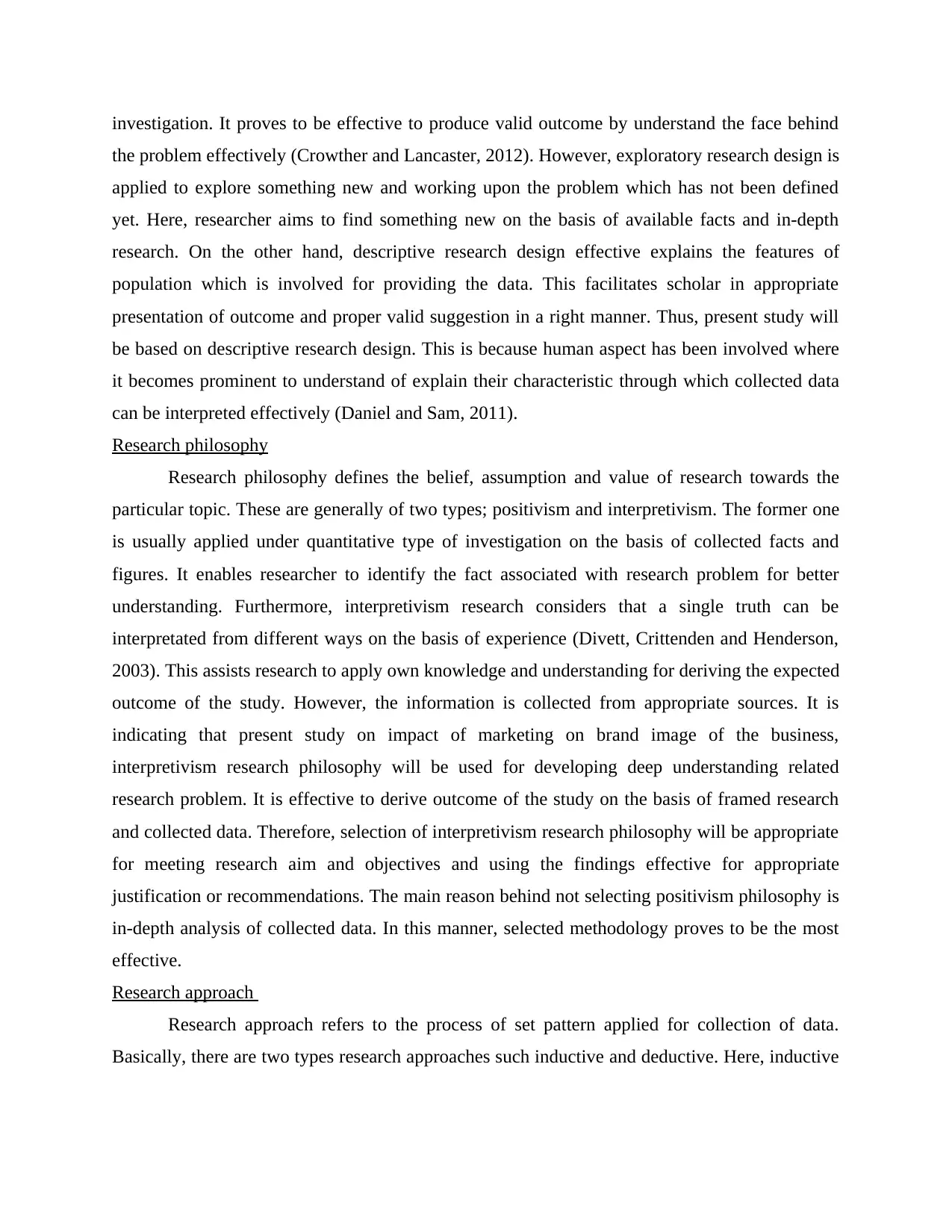
investigation. It proves to be effective to produce valid outcome by understand the face behind
the problem effectively (Crowther and Lancaster, 2012). However, exploratory research design is
applied to explore something new and working upon the problem which has not been defined
yet. Here, researcher aims to find something new on the basis of available facts and in-depth
research. On the other hand, descriptive research design effective explains the features of
population which is involved for providing the data. This facilitates scholar in appropriate
presentation of outcome and proper valid suggestion in a right manner. Thus, present study will
be based on descriptive research design. This is because human aspect has been involved where
it becomes prominent to understand of explain their characteristic through which collected data
can be interpreted effectively (Daniel and Sam, 2011).
Research philosophy
Research philosophy defines the belief, assumption and value of research towards the
particular topic. These are generally of two types; positivism and interpretivism. The former one
is usually applied under quantitative type of investigation on the basis of collected facts and
figures. It enables researcher to identify the fact associated with research problem for better
understanding. Furthermore, interpretivism research considers that a single truth can be
interpretated from different ways on the basis of experience (Divett, Crittenden and Henderson,
2003). This assists research to apply own knowledge and understanding for deriving the expected
outcome of the study. However, the information is collected from appropriate sources. It is
indicating that present study on impact of marketing on brand image of the business,
interpretivism research philosophy will be used for developing deep understanding related
research problem. It is effective to derive outcome of the study on the basis of framed research
and collected data. Therefore, selection of interpretivism research philosophy will be appropriate
for meeting research aim and objectives and using the findings effective for appropriate
justification or recommendations. The main reason behind not selecting positivism philosophy is
in-depth analysis of collected data. In this manner, selected methodology proves to be the most
effective.
Research approach
Research approach refers to the process of set pattern applied for collection of data.
Basically, there are two types research approaches such inductive and deductive. Here, inductive
the problem effectively (Crowther and Lancaster, 2012). However, exploratory research design is
applied to explore something new and working upon the problem which has not been defined
yet. Here, researcher aims to find something new on the basis of available facts and in-depth
research. On the other hand, descriptive research design effective explains the features of
population which is involved for providing the data. This facilitates scholar in appropriate
presentation of outcome and proper valid suggestion in a right manner. Thus, present study will
be based on descriptive research design. This is because human aspect has been involved where
it becomes prominent to understand of explain their characteristic through which collected data
can be interpreted effectively (Daniel and Sam, 2011).
Research philosophy
Research philosophy defines the belief, assumption and value of research towards the
particular topic. These are generally of two types; positivism and interpretivism. The former one
is usually applied under quantitative type of investigation on the basis of collected facts and
figures. It enables researcher to identify the fact associated with research problem for better
understanding. Furthermore, interpretivism research considers that a single truth can be
interpretated from different ways on the basis of experience (Divett, Crittenden and Henderson,
2003). This assists research to apply own knowledge and understanding for deriving the expected
outcome of the study. However, the information is collected from appropriate sources. It is
indicating that present study on impact of marketing on brand image of the business,
interpretivism research philosophy will be used for developing deep understanding related
research problem. It is effective to derive outcome of the study on the basis of framed research
and collected data. Therefore, selection of interpretivism research philosophy will be appropriate
for meeting research aim and objectives and using the findings effective for appropriate
justification or recommendations. The main reason behind not selecting positivism philosophy is
in-depth analysis of collected data. In this manner, selected methodology proves to be the most
effective.
Research approach
Research approach refers to the process of set pattern applied for collection of data.
Basically, there are two types research approaches such inductive and deductive. Here, inductive
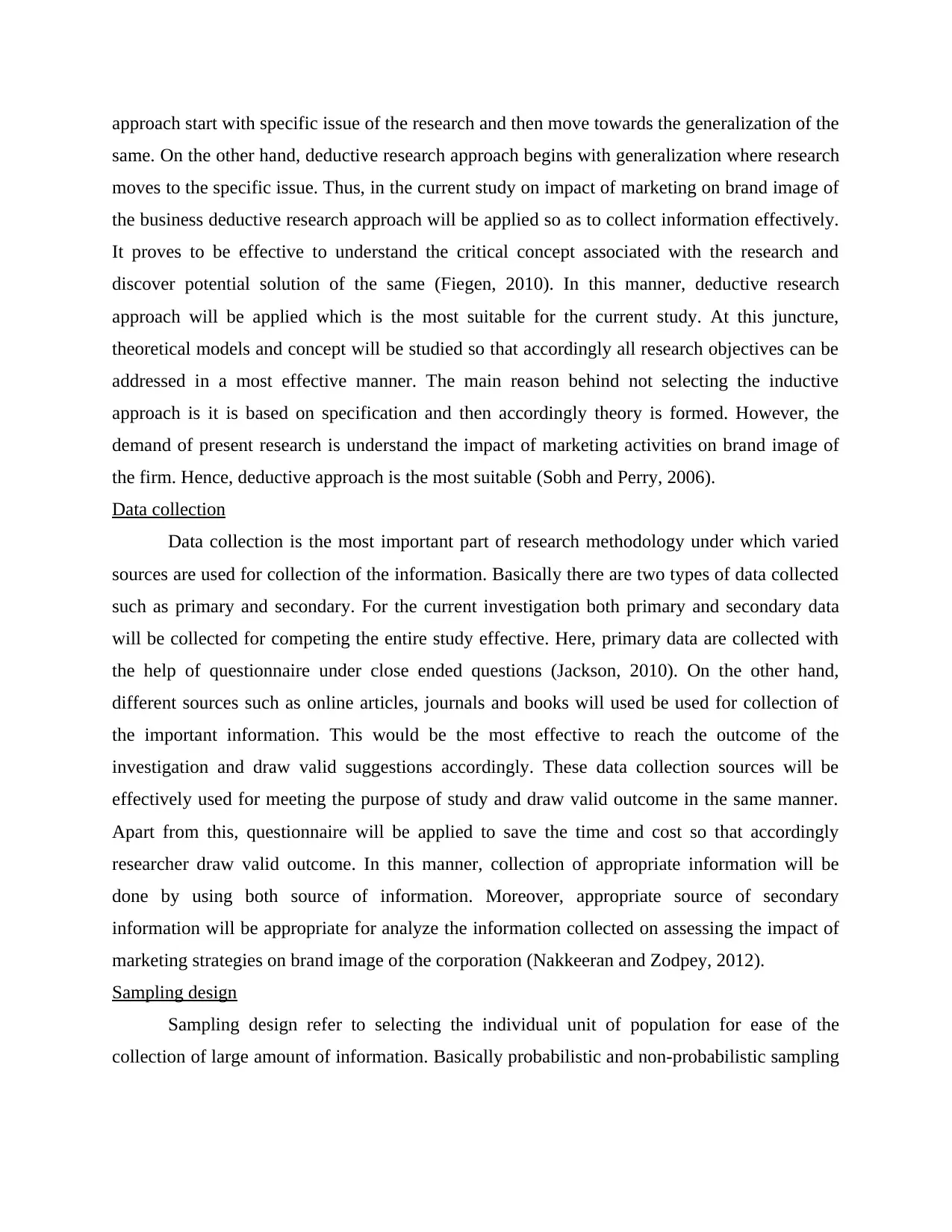
approach start with specific issue of the research and then move towards the generalization of the
same. On the other hand, deductive research approach begins with generalization where research
moves to the specific issue. Thus, in the current study on impact of marketing on brand image of
the business deductive research approach will be applied so as to collect information effectively.
It proves to be effective to understand the critical concept associated with the research and
discover potential solution of the same (Fiegen, 2010). In this manner, deductive research
approach will be applied which is the most suitable for the current study. At this juncture,
theoretical models and concept will be studied so that accordingly all research objectives can be
addressed in a most effective manner. The main reason behind not selecting the inductive
approach is it is based on specification and then accordingly theory is formed. However, the
demand of present research is understand the impact of marketing activities on brand image of
the firm. Hence, deductive approach is the most suitable (Sobh and Perry, 2006).
Data collection
Data collection is the most important part of research methodology under which varied
sources are used for collection of the information. Basically there are two types of data collected
such as primary and secondary. For the current investigation both primary and secondary data
will be collected for competing the entire study effective. Here, primary data are collected with
the help of questionnaire under close ended questions (Jackson, 2010). On the other hand,
different sources such as online articles, journals and books will used be used for collection of
the important information. This would be the most effective to reach the outcome of the
investigation and draw valid suggestions accordingly. These data collection sources will be
effectively used for meeting the purpose of study and draw valid outcome in the same manner.
Apart from this, questionnaire will be applied to save the time and cost so that accordingly
researcher draw valid outcome. In this manner, collection of appropriate information will be
done by using both source of information. Moreover, appropriate source of secondary
information will be appropriate for analyze the information collected on assessing the impact of
marketing strategies on brand image of the corporation (Nakkeeran and Zodpey, 2012).
Sampling design
Sampling design refer to selecting the individual unit of population for ease of the
collection of large amount of information. Basically probabilistic and non-probabilistic sampling
same. On the other hand, deductive research approach begins with generalization where research
moves to the specific issue. Thus, in the current study on impact of marketing on brand image of
the business deductive research approach will be applied so as to collect information effectively.
It proves to be effective to understand the critical concept associated with the research and
discover potential solution of the same (Fiegen, 2010). In this manner, deductive research
approach will be applied which is the most suitable for the current study. At this juncture,
theoretical models and concept will be studied so that accordingly all research objectives can be
addressed in a most effective manner. The main reason behind not selecting the inductive
approach is it is based on specification and then accordingly theory is formed. However, the
demand of present research is understand the impact of marketing activities on brand image of
the firm. Hence, deductive approach is the most suitable (Sobh and Perry, 2006).
Data collection
Data collection is the most important part of research methodology under which varied
sources are used for collection of the information. Basically there are two types of data collected
such as primary and secondary. For the current investigation both primary and secondary data
will be collected for competing the entire study effective. Here, primary data are collected with
the help of questionnaire under close ended questions (Jackson, 2010). On the other hand,
different sources such as online articles, journals and books will used be used for collection of
the important information. This would be the most effective to reach the outcome of the
investigation and draw valid suggestions accordingly. These data collection sources will be
effectively used for meeting the purpose of study and draw valid outcome in the same manner.
Apart from this, questionnaire will be applied to save the time and cost so that accordingly
researcher draw valid outcome. In this manner, collection of appropriate information will be
done by using both source of information. Moreover, appropriate source of secondary
information will be appropriate for analyze the information collected on assessing the impact of
marketing strategies on brand image of the corporation (Nakkeeran and Zodpey, 2012).
Sampling design
Sampling design refer to selecting the individual unit of population for ease of the
collection of large amount of information. Basically probabilistic and non-probabilistic sampling
⊘ This is a preview!⊘
Do you want full access?
Subscribe today to unlock all pages.

Trusted by 1+ million students worldwide
1 out of 15
Related Documents
Your All-in-One AI-Powered Toolkit for Academic Success.
+13062052269
info@desklib.com
Available 24*7 on WhatsApp / Email
![[object Object]](/_next/static/media/star-bottom.7253800d.svg)
Unlock your academic potential
Copyright © 2020–2025 A2Z Services. All Rights Reserved. Developed and managed by ZUCOL.





